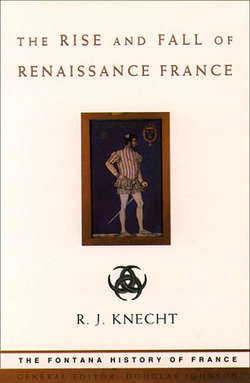Читать книгу The Rise and Fall of Renaissance France - R. Knecht J. - Страница 31
SIX Francis I: The first decade(1515–25)
Оглавление‘Kingship is the dignity, not the property, of the prince.’ These words spoken by a deputy at the Estates-General of 1484 embody the theory of royal succession which prevailed in late mediaeval France. The king, however absolute he might deem himself to be, was not free to dispose of the crown; he had to be succeeded by his nearest male kinsman. It was in accordance with this principle that François duc de Valois and comte d’Angoulême, Louis XII’s cousin, succeeded to the throne on 1 January 1515 at the age of twenty-one. His right to do so was unimpeachable, for it was a clearly established principle that ‘the king never dies’; he was to be followed immediately by his lawful successor. There was no possibility of an interregnum.
In the words of the English chronicler Edward Hall, Francis I was ‘a goodly prince, stately of countenance, merry of chere, brown coloured, great eyes, high nosed, big lipped, fair breasted and shoulders, small legs and long feet’. Ellis Griffith, a Welsh soldier in the service of Henry VIII, who was able to observe the French king closely at the Field of Cloth of Gold in 1520, tells us that he was six feet tall. His head was rightly proportioned for his height, the nape of his neck was unusually broad, his hair brown, smooth and neatly combed, his beard of three months’ growth darker in colour, his nose long, his eyes hazel and bloodshot, and his complexion the colour of watered-down milk. He had muscular buttocks and thighs, but his legs below the knees were thin and bandy, while his feet were long, slender and completely flat. He had an agreeable voice and, in conversation, an animated expression marred only by the unkingly habit of continually rolling up his eyes.
Contemporaries often remarked on Francis’s eloquence and charm. He would talk easily on almost any subject, though sometimes with more self-assurance than knowledge; he could also write well. The letters he wrote to his mother during his first Italian campaign are spontaneous and vivid; his verses display emotional sincerity. But Francis was first and foremost a man of action: he delighted in hunting, jousting and dancing. Dangerously realistic mock battles capable of inflicting serious injuries were a stock entertainment at his court. In hunting, as in war, Francis showed outstanding courage. During celebrations at Amboise in June 1515 he had to be dissuaded from engaging a wild boar in single combat.
Francis has gone down in history as a great lover. Women certainly loomed large in his life, though many stories about his amours are pure fantasy. That is not to say that his morals were irreproachable. He was dissolute and had probably contracted syphilis before 1524. About the time of his accession he was having an affair with the wife of Jacques Disomme, a distinguished parlementaire. Truth, however, is not easily distilled from gossip. Even the king’s first official mistress, Françoise de Foix, comtesse de Châteaubriant, is a shadowy figure. She seems to have had little or no political influence.
Three women were pre-eminent at Francis I’s court in the early part of his reign: his mother, his sister and his wife. Louise of Savoy, being a widow in her early forties, was free to devote herself to her son’s service. She was given a powerful voice in government and her influence was felt especially in foreign affairs. The king’s sister Marguerite was intelligent, vivacious, and quite attractive. In 1509 she married Charles duc d’Alençon, but the match proved unhappy. Marguerite found consolation in pious meditation and good works. She became attracted to the ideas of Jacques Lefèvre d’Etaples, leader of an evangelical group known as the Cercle de Meaux, and wrote religious poems which offended the narrowly orthodox ‘Sorbonne’, as the Paris Faculty of Theology is commonly known. Marguerite shared her mother’s interest in public affairs; foreign ambassadors often mentioned her in their dispatches. As for Queen Claude, she was widely renowned for her sweet, charitable and pious nature. Over a period of nine years she bore the king three sons and four daughters.
